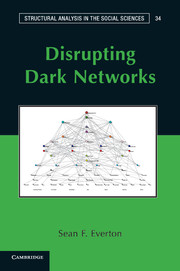Book contents
- Frontmatter
- Contents
- Figures
- Tables
- Preface
- Acknowledgments
- Part I Introduction
- Part II Social Network Analysis: Techniques
- Part III Social Network Analysis: Metrics
- 5 Network Topography
- 6 Cohesion and Clustering
- 7 Centrality, Power, and Prestige
- 8 Brokers, Bridges, and Structural Holes
- 9 Positions, Roles, and Blockmodels
- Part IV Social Network Analysis: Advances
- Part V Conclusion
- Appendix 1 The Noordin Top Terrorist Network
- Appendix 2 Glossary of Terms
- Appendix 3 Multidimensional Scaling with UCINET
- Appendix 4 The Just War Tradition
- References
- Index
8 - Brokers, Bridges, and Structural Holes
Published online by Cambridge University Press: 05 April 2013
- Frontmatter
- Contents
- Figures
- Tables
- Preface
- Acknowledgments
- Part I Introduction
- Part II Social Network Analysis: Techniques
- Part III Social Network Analysis: Metrics
- 5 Network Topography
- 6 Cohesion and Clustering
- 7 Centrality, Power, and Prestige
- 8 Brokers, Bridges, and Structural Holes
- 9 Positions, Roles, and Blockmodels
- Part IV Social Network Analysis: Advances
- Part V Conclusion
- Appendix 1 The Noordin Top Terrorist Network
- Appendix 2 Glossary of Terms
- Appendix 3 Multidimensional Scaling with UCINET
- Appendix 4 The Just War Tradition
- References
- Index
Summary
Introduction
Betweenness centrality, which we examined in the previous chapter, implicitly introduced the concept of brokerage, which is the idea that some actors are more likely to control the flow of resources than others. In this chapter we explore the notion of brokerage in more depth. We begin by looking at Ron Burt's (1992a, b) notion of structural holes, which builds upon Mark Granovetter's (1973, 1974) work regarding weak ties. Burt argues that actors who sit on either side of bridges (i.e., ties) that span gaps in the social structure (i.e., structural holes) are in a position to broker the flow of resources through the network. Somewhat related to Burt's approach is bi-component analysis, which identifies the bridges and actors (i.e., cutpoints) that if removed, disconnect the network (Wasserman and Faust 1994:112–115). Although the notion that the dissolution of certain ties or the isolation of particular actors will disconnect a network is intuitively appealing, in well-connected networks, it is often difficult to find such actors and bridges. Their removal may isolate one or two actors, but it may not disconnect the network in a substantive way. However, we can identify sets of actors, that if removed, will either disconnect a network or substantially fragment it (Borgatti 2006). This is known as the key player approach, and we will examine it in Section 8.4. Similarly, by measuring the degree to which a tie functions as a bridge in a network, we can ascertain which ties are more likely to disrupt the flow of resources through a network if they are removed (Freeman 2011; Girvan and Newman 2002). We take up this method in Section 8.6.
Implicit in all of these approaches is that identifying brokers and the ties that bind them reveals the cohesive subgroups of which they are (and are not) a part. Put differently, these approaches bring together aspects of the previous two chapters; Section 8.5 focuses on an algorithm that explicitly brings these two aspects together. It assumes that brokerage is a function of the different groups with which actors are affiliated; thus, not only does it require network data, but it also requires attribute data indicating the specific groups to which people belong.
- Type
- Chapter
- Information
- Disrupting Dark Networks , pp. 253 - 285Publisher: Cambridge University PressPrint publication year: 2012



